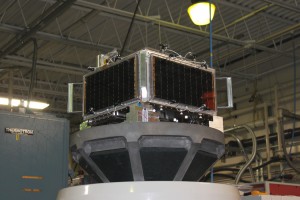Deployment of ARISSat-1/KEDR satellite expected August 3
After a postponed deployment in February from the International Space Station (ISS), the ARISSat-1/KEDR amateur radio satellite is expected to begin its mission on August 3, 2011. This was the word received from Energia official, Sergey Samburov during an ARISS teleconference on July 19. Deployment of the craft is planned during EVA-29.
NASA TV will cover the EVA live starting at 1400 GMT on August 3.
1430: Hatch Open
1446: Egress ARISSat-1 and secure to airlock ladder
1452: Remove solar panel covers
1507: Translate to deploy site, activate PWR, TIMER1 and TIMER2 switches, verify LEDs on, and deploy
(Internet streaming:http://www.nasa.gov/multimedia/nasatv/index.html)
ARISSat-1/KEDR is a satellite designed and built by amateur radio operators to specifically interest students in scientific and technological careers. Through the use of ham radio equipment, students and teachers should be able to access and utilize the satellite from a classroom environment with minimal set up.
ARISSat-1/KEDR is a cooperative effort between AMSAT, ARISS (Amateur Radio on the International Space Station,) RSC-Energia (The Russian Space Agency) and NASA. The design, development and construction of the satellite was done by AMSAT volunteers. Original plans called for the satellite to be housed inside an old Russian spacesuit, but when the suit became unavailable, a spaceframe was developed to house the radio equipment and solar panels. The new satellite was named ARISSat-1/KEDR. Another name for the spacecraft is RadioSkaf-V. The transmitted callsign will be RS01S.
The mission was specifically designed as an education-based satellite.
Some of its broadcast features include a voice identification, voice, digital and morse code telemetry, stored image and on-board camera transmissions via Slow Scan TV and digital telemetry from a Russian science experiment that will measure vacuum in earth’s lower atmosphere. Other aspects of the mission include CW (Morse code) and voice message contests to interest students in participating along with stored images submitted by students all over the world as part of its payload.

You must be logged in to post a comment.